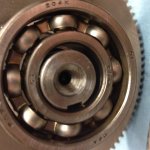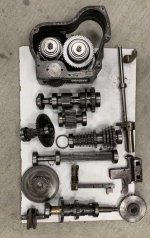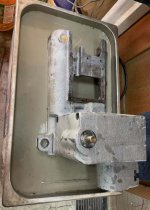Thanks Cal...
What you don't want to see bouncing around in the bottom of your gearbox as you are taking it apart:

It turns out that a previous owner had tried to disassemble the gearbox and didn't remove the double setscrew on the bottom of the casting.

The cone shaft end was a bit mangled from his hammering, but thankfully nothing that couldn't be recovered from.
The gearbox uses three different bearings. An 88505 on the input shaft right behind the feed pulley, one SKF type everywhere else, EXCEPT, one location which uses a smaller id.
I guess the previous guy didn't notice there was one different bearing and didn't bother reordering when he put it together. This is the bearing that was used in this location. I guess he just wanted a place holder.

What you don't want to see bouncing around in the bottom of your gearbox as you are taking it apart:

It turns out that a previous owner had tried to disassemble the gearbox and didn't remove the double setscrew on the bottom of the casting.

The cone shaft end was a bit mangled from his hammering, but thankfully nothing that couldn't be recovered from.
The gearbox uses three different bearings. An 88505 on the input shaft right behind the feed pulley, one SKF type everywhere else, EXCEPT, one location which uses a smaller id.
I guess the previous guy didn't notice there was one different bearing and didn't bother reordering when he put it together. This is the bearing that was used in this location. I guess he just wanted a place holder.






